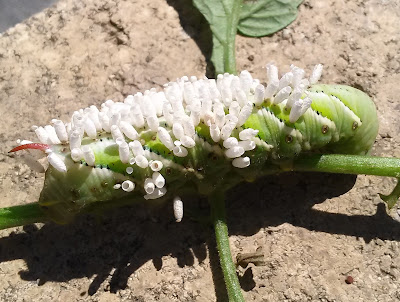Can
you identify what's in this photo?
Each Wednesday morning
on Camp Lutherlyn's Facebook page
the Lutherlyn Environmental
Education Program posts a photo.
Readers
have all morning and afternoon
to
make their best guess about what the photo is.
Around
6 pm LEEP provides the answer and a brief explanation.
Each
week's What is it Wednesday post
will
also be posted on the Nature of Lutherlyn blog,
after it is posted on Facebook,
sometimes
with additional bonus information.
In
addition to bringing you current editions of What is it Wednesday
on the
Nature of Lutherlyn blog,
we
will be reposting old editions,
creating
a What is it Wednesday archive.
This photo was posted as a What is it Wednesday on
July 29, 2020.
And
the answer is....
This is bear scat, found near Baker Chapel last week!
We
know it is bear scat because of the size. The shape and look of the scat is
similar to raccoon scat, but about twice as big. Occasionally we find scat here
in a pile almost this big, but it is more like a soft blob – sometimes deer
scat looks like that instead of a pile of small pellets, depending on what the
deer have been eating. The only other scat we find here that is that big is
horse manure!
Last week we noticed that some large and heavy garbage cans
had been knocked over around camp. Then we found a pile of scat like this one
near the dining hall, and this one near the chapel. We have had a black bear
hanging around camp! We made sure all the garbage cans were emptied and guests
stored all food inside and put all food garbage into the dumpster instead of
individual cans, and we have not had any problems since. It is fine to have a
bear around occasionally, but we do not want one to get accustomed to eating
garbage here. It is not good for the bear; and although black bears are not
aggressive, we would have to change some of our behaviors too if we were regularly
living alongside bears here at Lutherlyn.
Though we don’t have any resident bears at Lutherlyn, every few years a bear is spotted here, passing through on its way somewhere else. Bear cubs, which are born in January or February, stay with their mothers for about a year and a half. So, this time of year, last year’s cubs are leaving their families and striking out to find a home range of their own. Estimates vary, but black bears need at least 2.5 square miles of habitat of mostly forest, and in many cases they use much more. There is just not that much uninterrupted forest at and around Lutherlyn to provide a good home for bears. Lutherlyn's property is slightly more than one square mile (though in an irregular shape, not a square) and not all forest, and we are mostly not surrounded by forest. However, nearby Moraine State Park does have that much forest, and bears do live there. It is always exciting to see evidence of these beautiful and powerful creatures!
Like and follow Camp Lutherlyn on Facebook, to see What is it Wednesday posts when they come out and have the opportunity to share your guesses in the comments!












